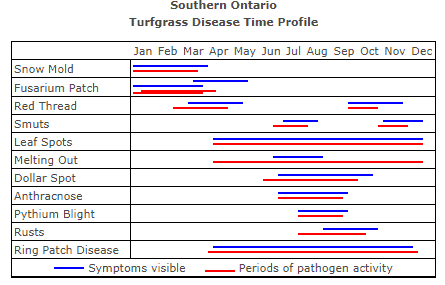Pest & Weed Identification Database
Pest & Weed Identification Database
Weed Grass Identification
Weed Identification
Pink & Grey Snow Mold
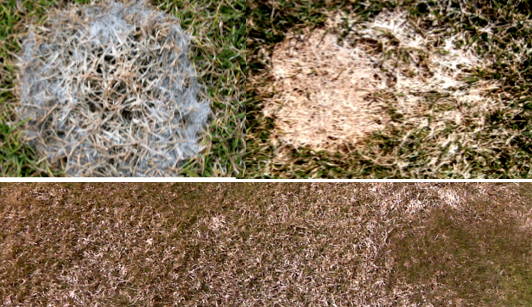
On This Page:
ToggleInfo
- Fungal disease
- Circular, patchy areas of dead, matted grass
- White to light grey in colour, sometimes with pink tones
- Most noticeable in areas of heavy snow load & areas that retain moisture
Time of Year
- Early spring, immediately after snow melts
- Snow mould is most active when temps are just above freezing & conditions are moist
Treatment
- Lightly rake out to increase air circulation and allow for new growth
- Areas of severe damage may require aeration & overseeding
- Maintain at 2 3/4" - 3" and remove leaves from lawn in fall to minimize damage
- Sunny areas recover before shady areas
Fusarium Blight “Summer Patch”
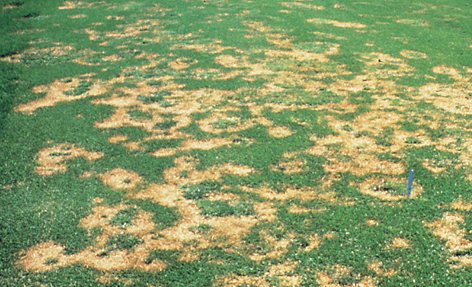
Info
- Fungal disease
- Circular, crescent, or streaky patches
- Affected areas change colour in hot weather from light green to reddish brown, to tan, finally to straw-coloured
- Most noticeable in moist areas
Time of Year
- During hot, humid temps between 24°C & 32°C
- Spore production begins above 21°C
- Affected grass may die 4-7 days after first symptoms appear
Treatment
- Lightly rake out to increase air circulation and allow for new growth
- Areas of severe damage may require aeration & overseeding
- Maintain height at 2 3/4" - 3"
- Aerate annually
- Fertilize regularly
- Collect lawn clippings to reduce thatch build-up
Dollar Spot
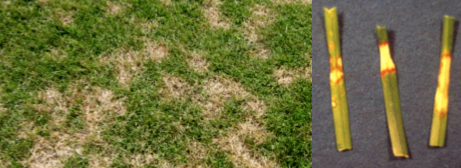
Info
- Straw-coloured patches 1"-3" in diameter
- Hourglass-shaped lesions on grass blades, darker brown at edges
Time of Year
- Spring through fall
- Most active when daytime temps are warm & moist, followed by cool nights
Treatment
- Fertilize regularly
- Water deeply less often, water in a.m. to allow leaf blades to dry
- Aerate annually
- Avoid drought stress
Fairy Ring
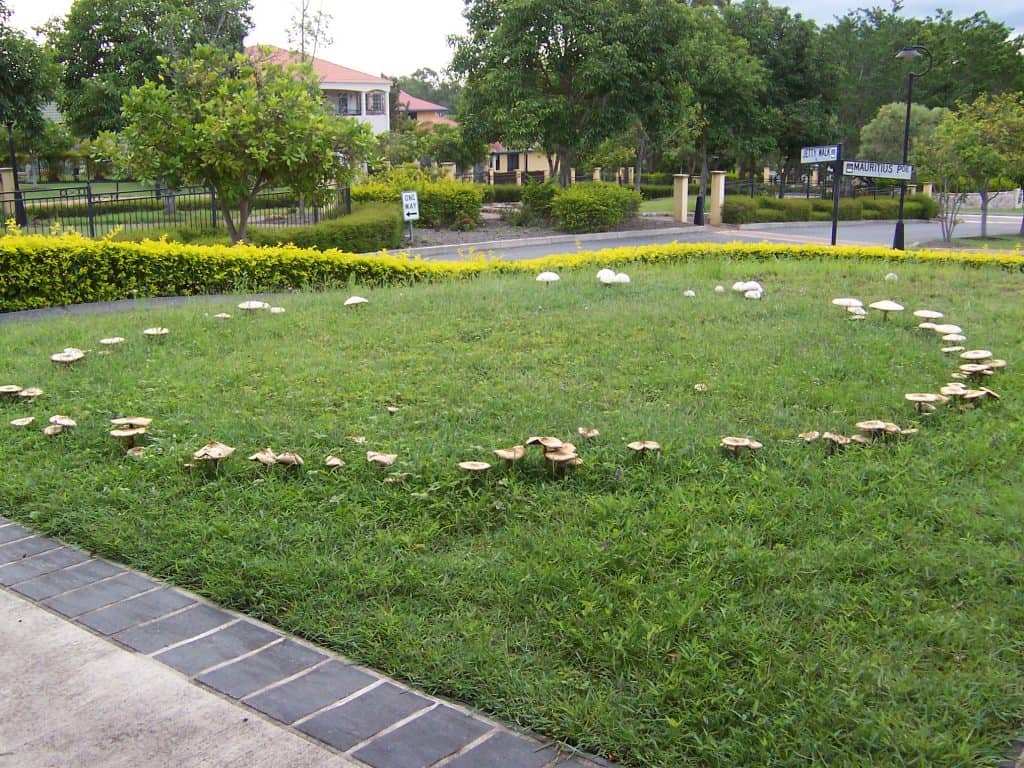
By User:Mrs skippy - Own work, Public Domain, https://commons.wikimedia.org/w/index.php?curid=3352618
Info
- Arc of darker green, often with mushrooms
- Soil inhabiting fungus
- Mushrooms are most commonly seen after rain
- Arcs can span several meters
Time of Year
- Spring and summer
- Can reoccur year to year, expanding in size
- Mushroom production may cease during extended cool periods, drought, and other unfavourable conditions
Treatment
- Rake out mushrooms
- Aerate annually to reduce thatch
- Fertilize regularly
- Maintain height at 2 3/4" - 3", mowing every 5-7 days
- Digging out and re-sodding may be required for stubborn areas of activity
- Water in a.m.
Red Thread
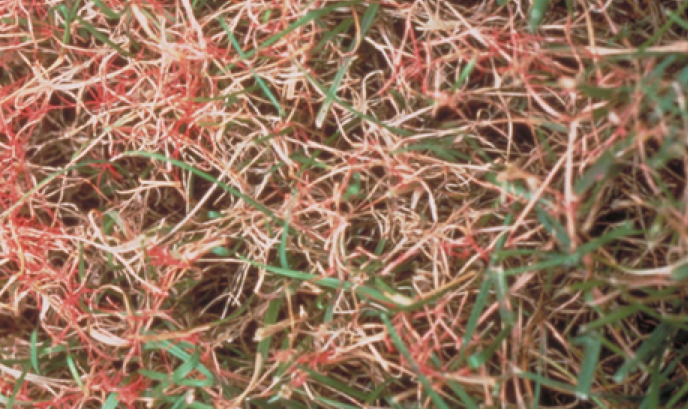
Info
- Affects mainly ryegrasses and fine fescues, but all types are susceptible
- Red-brown patches
- Fine "threads" of mycelium grow from the tips of infected leaf blades
Time of Year
- Spring and fall, when grass is growing slowly
- Cool temps between 4°C - 21°C
- More than 10 hrs leaf wetness per day for several days
- Humid periods
Treatment
- Fertilize regularly
- Aerate annually to reduce thatch
- Mow every 5-7 days to remove diseased portion of grass blade
- Water deeply less often, water in a.m. to allow leaf blades to dry
- Maintain pH at 6.5 - 7.0
Necrotic Ring Spot
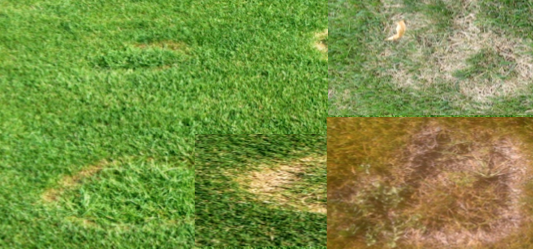
Info
- Light green to yellow semi-circular patches
- Bluegrass and fine fescue are most susceptible
- More severe on compact and clay soils
Time of Year
- Disease activity begins with hot, humid temps (above 26°C)
- Severity of symptoms increases with heat and drought
- Late spring, but also occurs in early fall
- Fungus may go dormant over hot summer months
Treatment
- Use a slow-release fertilizer in spring
- Fertilize regularly
- Avoid drought stress
- Aerate annually to reduce thatch
- Maintain height at 2 3/4" - 3"
- Overseed to introduce more resilient grass types
Rust

Info
- Rust-coloured powdery masses of spores on leaf blades or sheaths
- Rust spores easily come off on shoes, equipment
- Rust is non-harmful, non-toxic for kids and pets
Time of Year
- Temps between 20°C – 30°C
- Severe on turf with drought stress
- Occurs in areas of shade, poor air circulation
Treatment
- Fertilize regularly
- Mow every 5-7 days to remove diseased portion of grass blade
- Maintain height at 2 3/4″ – 3″
- Water in am
- Aerate annually to reduce thatch
- Lightly rake to increase air circulation
Rhizoctonia Blight “Brown Patch”
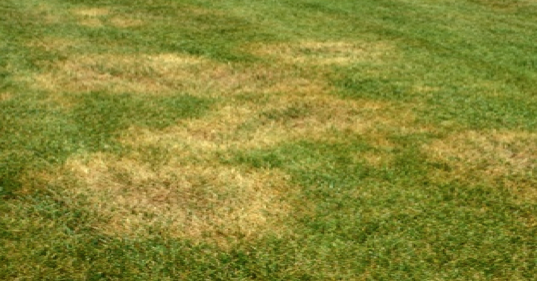
Info
- Fungal disease
- Leaf blades have similar lesions to dollar spot, but not as bleached
- Circular patches a few inches to several feet
- "Smokey" border can appear after morning dew
Time of Year
- More than 10hrs leaf wetness per day for several days
- Night temps under 16°C for cool-season grasses
- Most severe in areas of low mowing height
Treatment
- Fertilize regularly
- Maintain height at 2 3/4" - 3"
- Aerate annually to reduce thatch, improve drainage
- Water in am
- Rake out dead organic material to increase air circulation, allow for new growth
Vole Damage


By Original by Soebe, edited by Fashionslide - Own work, CC BY-SA 3.0, https://commons.wikimedia.org/w/index.php?curid=10198072
Info
- Often confused w/moles
- Underground tunnels appear as branching "cracks" in turf
- Often near mulch beds, sheds, compost heaps, and other means of shelter
- Herbivores, feed on root systems, tuber seeds
Time of Year
- Seen in spring after snow melts, when tunnels created over the winter months become evident
- Often seen in new developments that were previously open fields, farm lands
Treatment
- Rake out damaged areas
- Aerate if damage is severe
- Overseed/spot seed
- Reduce areas of mulch and ground cover to encourage natural predators
Mole Damage
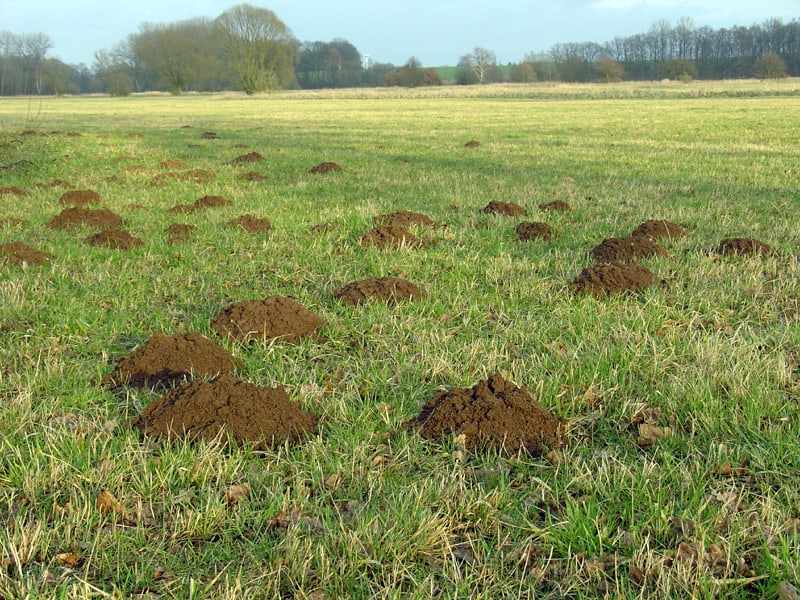
By Karelj - Own work, Public Domain, https://commons.wikimedia.org/w/index.php?curid=2464250
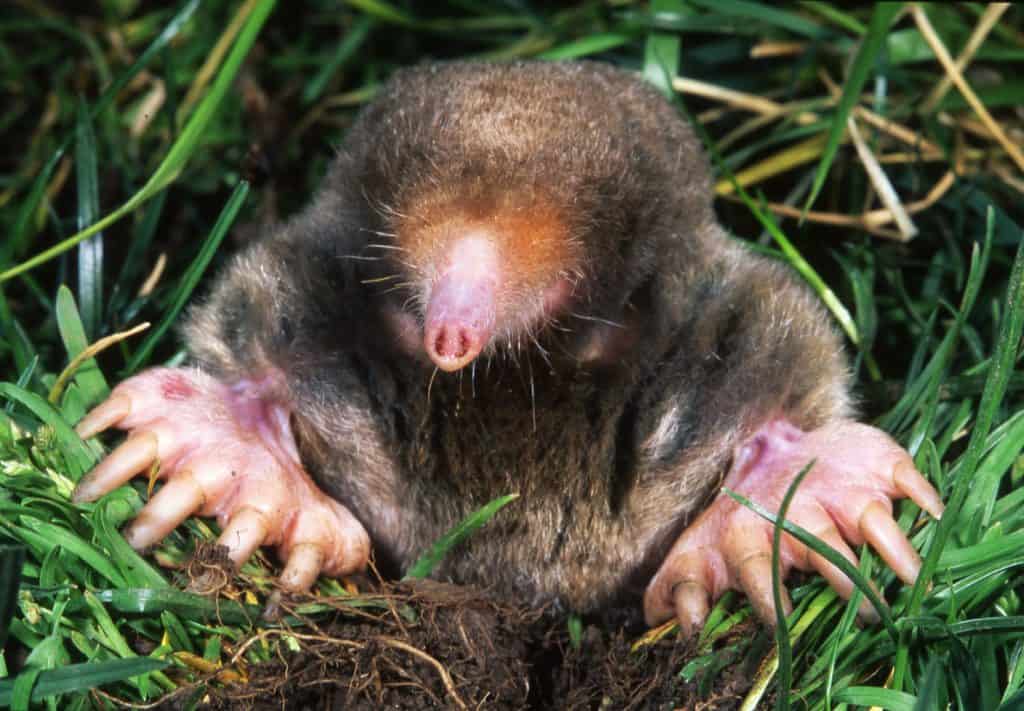
By Kenneth Catania, Vanderbilt University, CC BY-SA 3.0, https://commons.wikimedia.org/w/index.php?curid=8923296
Info
- Underground tunnels are deeper than voles (avg 10cm - 15cm deep)
- Damage appears as erupted soil mounds or "mole hills"
- Carnivores, feed on grubs, larvae, earthworms, beetles
Time of Year
- Burrowing occurs over night to early morning
- Seen in spring after snow melts, when tunnels and hills created over the winter months become evident
- Often seen in new developments that were previously open fields, farm lands
Treatment
- Trap moles over winter months
- Reduce food supply
- Rake out damaged areas
- Aerate if damage is severe
- Overseed/spot seed
Dog Damage

Info
- Circular or blotchy patches
- Burnt centre (yellow) with dark green around the edges
- Pet urine contains Nitrogen salts (also found in fertilizer) and essentially burns grass by over-dosing the central area where the highest concentration of nitrogen is.
- Similar to Necrotic Ring Spot, however dark green edges are a telltale sign
Time of Year
- Any time of year, although damage is most severe when ground is frozen or hard after a winter, or prolonged drought
Treatment
- Water immediately after dog urinates to dilute urine- even a cup or two is enough
- Train dog to use a paved area, mulch or dog run
- Use Gypsum soil conditioner regularly to mitigate changes in soil pH caused by urine and to help flush the salts through the soil
Fertilizer Burn
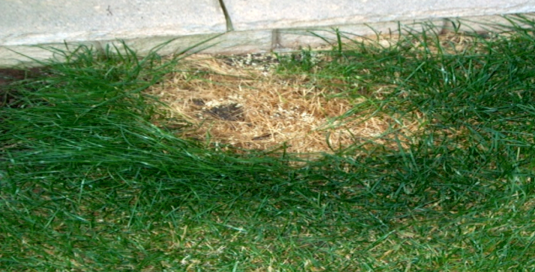
Info
- Blotchy burnt patches
- Darker green striping
- Lots of granules of fertilizer seen clustered within damaged areas
- Edges of damage are darker green
- Faster, thicker growth at edges of damage
Time of Year
- Man-made damage, can occur any time fertilizer is incorrectly applied
- Burns can be more severe when lawn is under drought stress
- More common when spreading by hand
Treatment
- Remove any spilled fertilizer immediately
- Water area deeply
- After damage occurs, rake out area well to remove dead organic matter and any remaining fertilizer granules, re-seed
- Severe damage may require re-sodding
- A shop vac is best!
Drought

Info
- Bleached out areas of grass
- Straw-like texture
- Dry to the touch
- Most obvious near paved areas (sidewalks, driveways) from radiating heat
Time of Year
- Mid-summer, during hottest months
- Most severe on lawns that receive inadequate/improper irrigation
- Drainage areas will be most resilient
Treatment
- Water deeply, max. twice a week
- Ensure all lawn areas get a min. 1 1/2" - 2" of water each week
- Severe damage may require aeration and overseeding in fall to repair
Excess Thatch
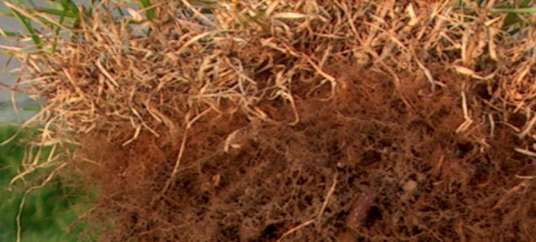
Info
- More than an inch of dead organic material
- Can cause a variety of diseases
- Impedes drainage and air circulation
- Provides food and shelter for insects
Time of Year
- In spring, as a result of snow mould and other damages
- Most noticeable while investigating symptoms of disease
Treatment
- Mow more often, every 5-7 days
- Bag heavy clippings
- Aerate annually
- Rake out dead organic material as needed, esp. in fall
- Dethatching may be required for extreme cases
Mechanical Damage

Info
- Caused by heavy mowers/trimmers, tires etc.
- Vehicle traffic
- Garbage pails/recycling bins left on lawn
Time of Year
- Any time of year
- Equipment sinks into soft ground
- Damage can be more severe when lawn is under drought stress
- Suffocates lawn
- Tears fragile blades
Treatment
- Prevent further damage by following recommended cultural practices
- Rake out damage, may need aeration and overseeding
Insect Identification
Grub (larvae), European Chafer Beetle, “May/June Bug/Beetle” (adult)
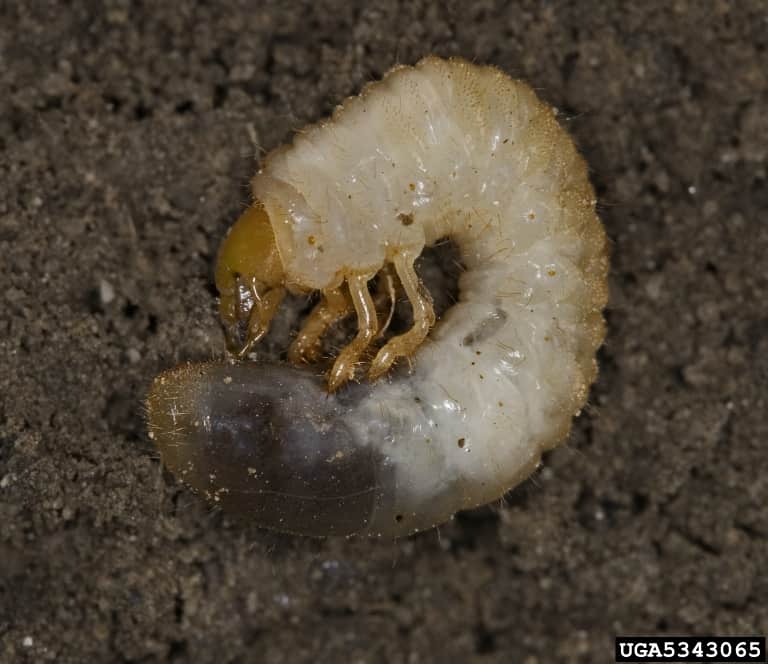
By David Cappaert, Michigan State University, Bugwood.org - http://www.forestryimages.org/browse/detail.cfm?imgnum=5343065, CC BY 3.0, https://commons.wikimedia.org/w/index.php?curid=10273201
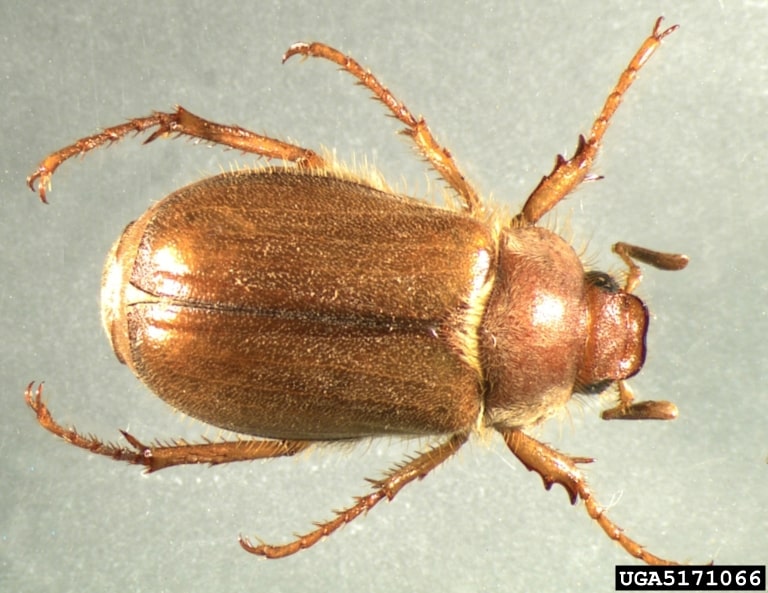
By Mike Reding & Betsy Anderson, USDA Agricultural Research Service - http://www.forestryimages.org/browse/detail.cfm?imgnum=5171066, Public Domain, https://commons.wikimedia.org/w/index.php?curid=10273170
Info
- Grubs have a white body, orange/brown head
- C-Shaped larvae of a large group of beetles called "scarabs"
- Can destroy a lawn by feeding at the root system
- A healthy lawn can support several grubs per square foot
Damage
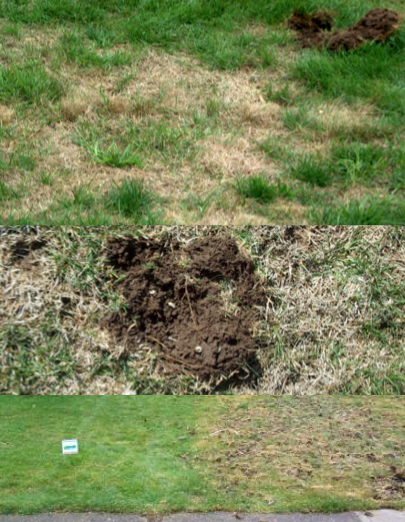
Timing & Location
- Predominantly Fall root feeding activity of grubs feeding on roots with minor amounts of spring feeding
- Grubs prefer to feed in open, sunny areas with preference to South facing lawns and the South sides of trees
- Grubs begin feeding late summer and early fall through to ground freeze up
- Associated damage becomes more noticeable as temps warm up when root activity should begin
- 'June Beetle' Grubs can feed through heat of mid-summer since they have a longer 2-3 year life cycle.
- During late spring into early summer, European Chafer and Japanese Beetle grubs pupate beginning the process into adult beetles- no control is effective at this time.
- Beetles emerge early to mid-summer
- Beetles mate and lay eggs mid/ late summer
- Eggs hatch, first instar grubs begin feeding in late summer/early fall ** this is the ideal time for Nematode treatment!!! **
- Most damage occurs during fall, however damage may not be noticeable until late winter or in early spring since fall is an excellent growing time for cool season turfgrass root growth
What To Look For
- Animals digging on the lawn may indicate grubs
- General browning of the lawn, similar to drought stress
- Discolouration that wilts rapidly in the hot sun
- Spongy feel
- Grass pulls up easily, rolls back like a carpet
- Grubs should be seen feeding on root system
Recommendation
- Treat with Nematode grub management over several seasons to mitigate grub activity
- Fold back torn up areas of grass, pat/step down on area to ensure good root-soil contact, and keep area moist to restore
- Aerate and OverSeed to repair large areas of damage
- For severe damage, consider PowerSeeding
- Deter animal activity with motion-activated sprinklers/lights, dog scent, chicken wire, cayenne pepper, etc.
Chinch Bug
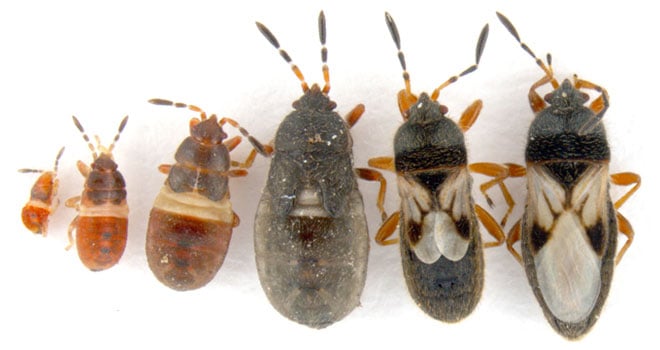
Info
- Nymphs (babies) are red with a white stripe
- Mid-stage chinch are red, white and black
- Adults have an hourglass shape on their backs
- Nymphs are a few mm in length
- Adults are less than 1 cm
- Can destroy a lawn using its piercing mouth to suck the sap from grass blades
- Saliva contains a substance that allows sap to be sucked out easier but is toxic to the grass blades
- A healthy lawn can sustain some chinch activity
- Only nymphs actively cause damage to the lawn
Damage
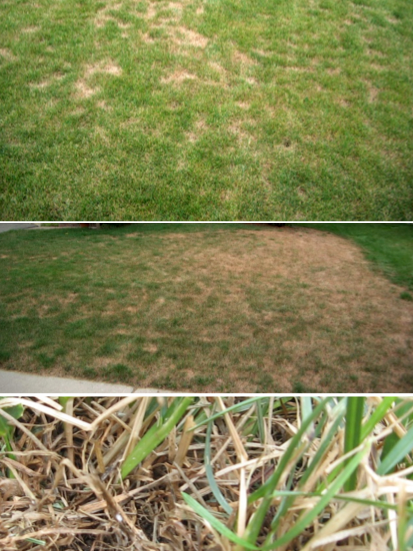
Timing & Location
- Lawns that receive improper/inadequate irrigation are more prone to severe damage
- Adult chinch emerge in late spring (mid-late May) to lay eggs in the lawn
- First nymphs can usually be seen in early June
- Nymphs become adults by late July
- Damage becomes most apparent during typically dry season in August
- Chinch bugs hibernate through the winter months under trees, in shrubs, garden beds, etc.
- Often, damage begins in hot areas of close proximity to gardens, lawn edges ** Use a can to check chinch levels - cut off both ends of the can, and press it firmly into the soil. Fill with water. Chinch bugs should float to the surface and give you a better idea of population density **
What To Look For
- Begins with small, circular patches of sunken yellowing/browning grass
- Damage radiates out from this point in an irregular pattern
- Damaged grass is dry, straw-like
- Chinch bugs will be seen active in the thatch layer at edges of damaged areas
- Root system is still intact/grass does not pull out by the roots easily
- Damage will accelerate quickly during a drought
Recommendation
- Water area deeply and keep it moist - chinch do not like moisture!
- Rake out any dead areas to allow roots to sprout new growth
- Aerate yearly to reduce thatch build-up
- Aerate and overseed to repair large areas of damage
- For severe damage, consider powerseeding
- Use an endophyte enhanced seed to discourage future activity
- Continue with good cultural practices
- Order chinch bug mgmt if not incl in pkg
Leather Jacket (larvae), Crane Fly (adult)
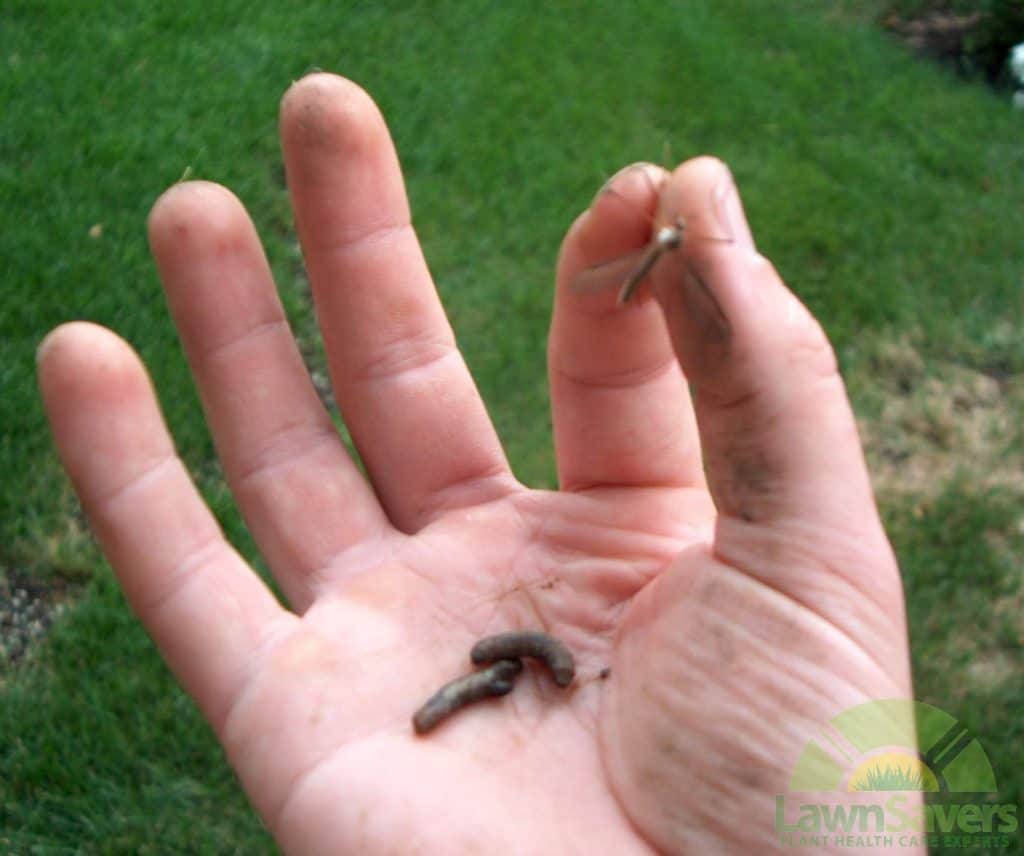
Info
- Leather jackets are stubby, brownish grey worms approx. 2cm-3cm long
- Crane flies are often called "mosquito eaters" although they feed on nectar or nothing at all
- Crane flies vary in size
- Leather jackets cause damage to a lawn by feeding at the root system
Damage
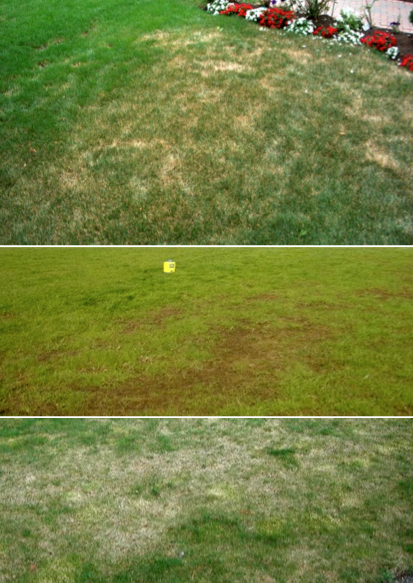
Timing & Location
- Early spring, fall
- Prefer moist environments
- Leather jackets emerge from deep in the soil in early spring and begin feeding earlier than grubs
- Leather jackets become crane flies in late summer and hatch within 2 weeks
- Newly hatched leather jackets will continually feed through the fall months
- Fall is the best time for treatment, as newly hatched leather jackets have not reached full size and are easier to destroy
- Egg laying often occurs in swales and drainage areas, shady spots that retain morning moisture
What To Look For
- Similar to grub damage
- Animals digging on the lawn
- Damage appears similar to drought stress
- Spongy feel
- Grass pulls up almost as easily as with grub damage
- Leather jackets seen feeding at the root system
- Leather jackets on patios/paved areas adjacent to lawn after rain fall
- Crane flies seen in doorways, near light fixtures in the morning/evenings of later summer months
Recommendation
- Nematode treatments in fall to mitigate leather jacket populations
- Fold back torn up areas of grass, pat down area to ensure good root-soil contact, and keep area moist to restore
- Aerate and overseed to repair large areas of damage
- For severe damage, consider power-seeding
- Deter animal activity with motion-activated sprinklers/lights, dog scent, chicken wire, cayenne pepper, etc.
Sod Webworms
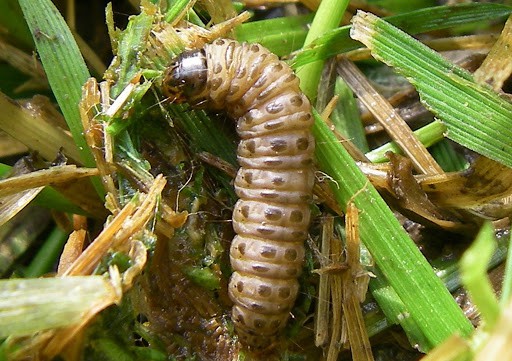
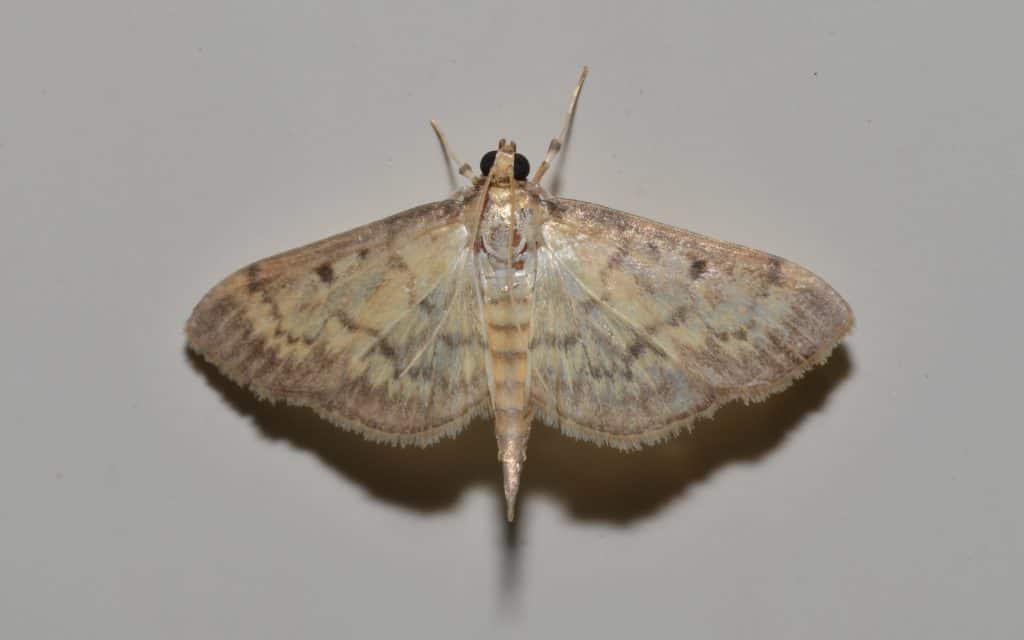
By Andy Reago & Chrissy McClarren - Herpetogramma fluctuosalis – Greater Sweet Potato Webworm Moth, CC BY 2.0, https://commons.wikimedia.org/w/index.php?curid=34603010
Info
- Refers to a number of small caterpillars that feed on turf root systems
- Larval stage of small moths
- Approx. 1cm-2cm long
- Often light in colour with rows of darker spots on their back
- Dark orange/brown head
Damage
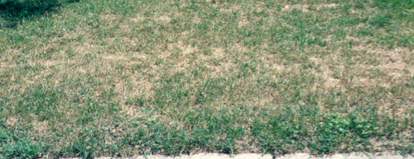
"Damage is caused by sod webworms chewing off the grass stems/leaves while feeding during the summer/early fall. Dead patches of grass will pull away easily in clumps revealing masses of silk-like material with green excrement (frass) left by the larvae. "
Timing & Location
- Moths lay eggs in the lawn during evenings in early-mid summer
- Eggs hatch in about one week
- Sod webworms prefer sunny, dry locations
- Often found in areas of dense thatch (near pines)
- Damage becomes most apparent during typically dry season in July/August
- Several generations can occur in one year if conditions are ideal
What To Look For
- Birds pecking at the lawn, especially after rain fall
- Sod webworms tunnelling through the thatch layer
- Many small moths within the grass, especially in mornings and evenings
- Similar symptoms as grub damage
Recommendation
- Manage thatch layer accordingly
Please call office for current treatment(s)
Cutworm
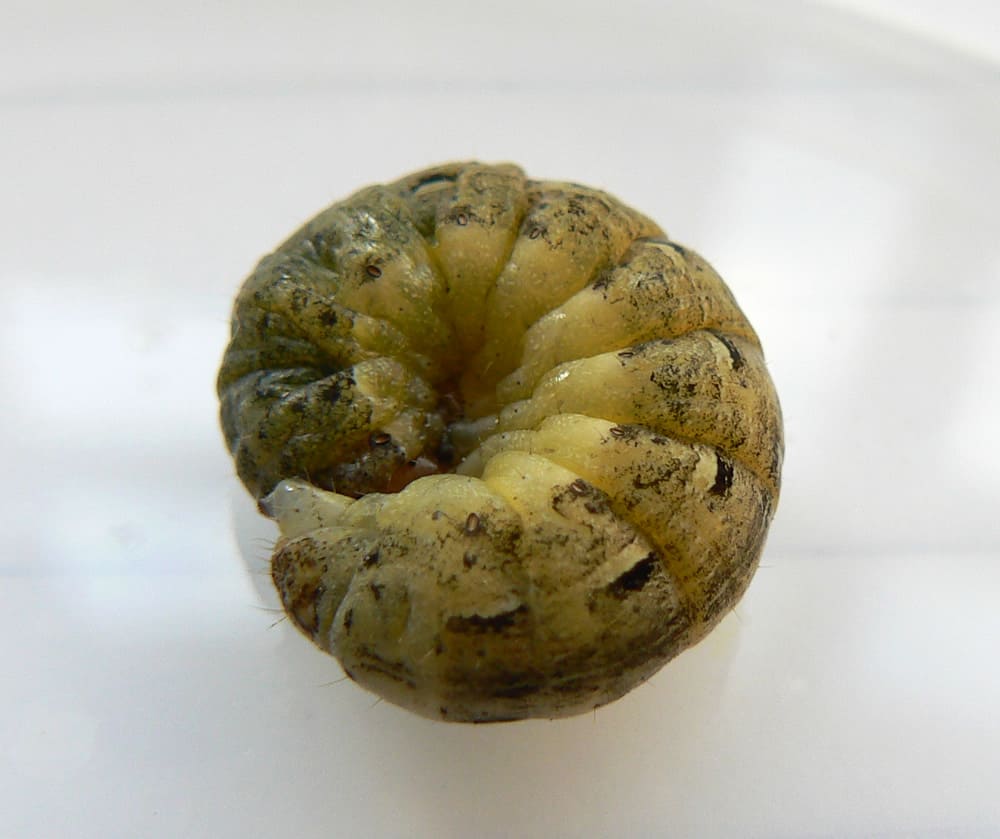
By Neil Phillips from uk - Large Yellow Underwing caterpiller, CC BY 2.0, https://commons.wikimedia.org/w/index.php?curid=3837019
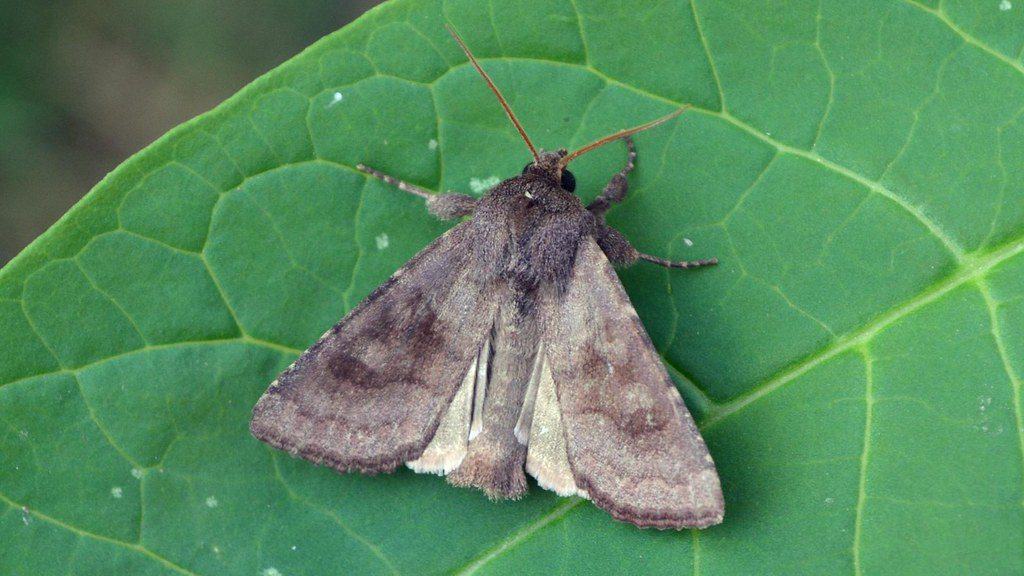
Info
- Dark coloured caterpillars that feed on plant stems and turf, can be several cm long
- Usually feed overnight
- Adults are large, greyish brown moths
- "Cut" plants off at the stem
Damage

Cutworm larvae usually feed during the night and take shelter in the day. Stems, leaves and roots of grass plants may be injured, leaving yellowish brown dead patches with a hollow hole in the middle of the circle.
Timing & Location
- Moths lay eggs in the lawn during evening in spring
- Cutworms emerge in early summer and begin feeding
- Damage becomes apparent throughout early-mid summer
- Many types of cutworm pupate over the winter months after burrowing deeper into the soil
What To Look For
- Birds pecking at the lawn, especially after rain fall
- Small holes in the lawn
- Cutworms tunnelling through the thatch layer or on the surface of the soil
- Similar symptoms as grub damage
Recommendation
- Manage thatch layer accordingly
Please call office for current treatment(s)
Billbug

Info
- Larvae are legless, with a white body and brown head
- Adult billbugs have hard bodies and are dark grey or black, approx. 5mm long
- Life cycle lasts one year
Damage

The adults may cause minor damage to the lawn by chewing holes in the grass blades. Larvae feed on the grass roots and stems often cutting the roots and stems of the blades off, allowing the plant to be pulled up easily. Large areas of your lawn may appear wilted with a yellowish brown colour, however it will not respond to proper watering/irrigation.
Timing & Location
- Adults can be seen on patios and walkways in the spring/fall
- Adults live in the thatch layer during the active growing season
- Adults survive winter in protected areas like gardens
- Eggs are laid in late June and hatch within 2 weeks
- Larvae feeds until they pupate into adults in early fall
What To Look For
- Active adult billbugs throughout the lawn and garden areas, or on patios/walkways
- Damage is similar to drought
- Similar symptoms as other larvae-caused damage
Recommendation
- Manage thatch layer accordingly
Please call office for current treatment(s)
Weed Identification
Dandelion (Taraxacum officinalis)

Treatment(s)
- Fiesta Weed Management with several applications as it weakens the weed
- Manual removal
- Proper Fertility and soil nutrients
- OverSeeding
- Frequent and consistent mowing at the proper height of 2.75-3" with a sharp blade. Bag clippings when the weeds are in flower and seed. Never allow the lawn to grow to more than 5".
- Watering consistently each week by providing a minimum of 1" of water. do not water more than 2-3 times per week. Thunderstorms do not count.
Timeframe For Activity
- Germinates at min. 10°C
- Prefers moist areas, full sun but will grow in a variety of conditions
Info
- Dandelions are the primary target weed of Fiesta
- Perennial weed
- Spreads through seeding, prevent dandelions from going to seed and from developing extensive root systems by mowing frequently
- Bag clippings once weeds have seeded
Recommendations
- Mow every 5-7 days, maintaining height at 2 3/4" - 3"
Plantain (common) (Plantago major)

By Iorsh at English Wikipedia - Transferred from en.wikipedia to Commons., Public Domain, https://commons.wikimedia.org/w/index.php?curid=1451495
Treatment(s)
- Fiesta Weed Management over several visits
- Manual removal
- Proper Fertility
- Frequent and consistent mowing at the proper height of 2.75-3" with a sharp blade. Bag clippings when the weeds are in flower and seed. Never allow the lawn to grow to more than 5".
- Watering consistently each week by providing a minimum of 1" of water. do not water more than 2-3 times per week. Thunderstorms do not count.
Info
- Perennial weed - common along roadways and driveways
- Aggressive root system allows for growth in compact soils
- Spreads through seeding, prevent plantain from spreading by mowing frequently
- Bag clippings once weeds have gone to seed to prevent spread
Recommendations
- Mow every 5-7 days, maintaining height at 2 3/4" - 3"
Thistle (Cirsium arvense)

Public Domain, https://en.wikipedia.org/w/index.php?curid=1516545
Treatment(s)
- Fiesta weed management over several visits
- Manual removal
- Frequent and consistent mowing at the proper height of 2.75-3" with a sharp blade. Bag clippings when the weeds are in flower and seed. Never allow the lawn to grow to more than 5".
- Watering consistently each week by providing a minimum of 1" of water. do not water more than 2-3 times per week. Thunderstorms do not count.
Timeframe For Activity
- Flowers late spring-early summer, seed heads develop actively through late July into fall
Info
- Perennial weed - spreads through seed and root system budding
- Infestations tend to start in damaged/ disturbed turf or when properties are adjacent to ravines, parks or naturalized areas.
- seeds can fly through air from very far away
- never let flowerheads develop
- Can be difficult to treat as roots can extend 15' vertically, 6'-15' horizontally
Recommendations
- Mow every 5-7 days, maintaining height at 2 3/4" - 3"
Clover (white) (Trifolium repens)
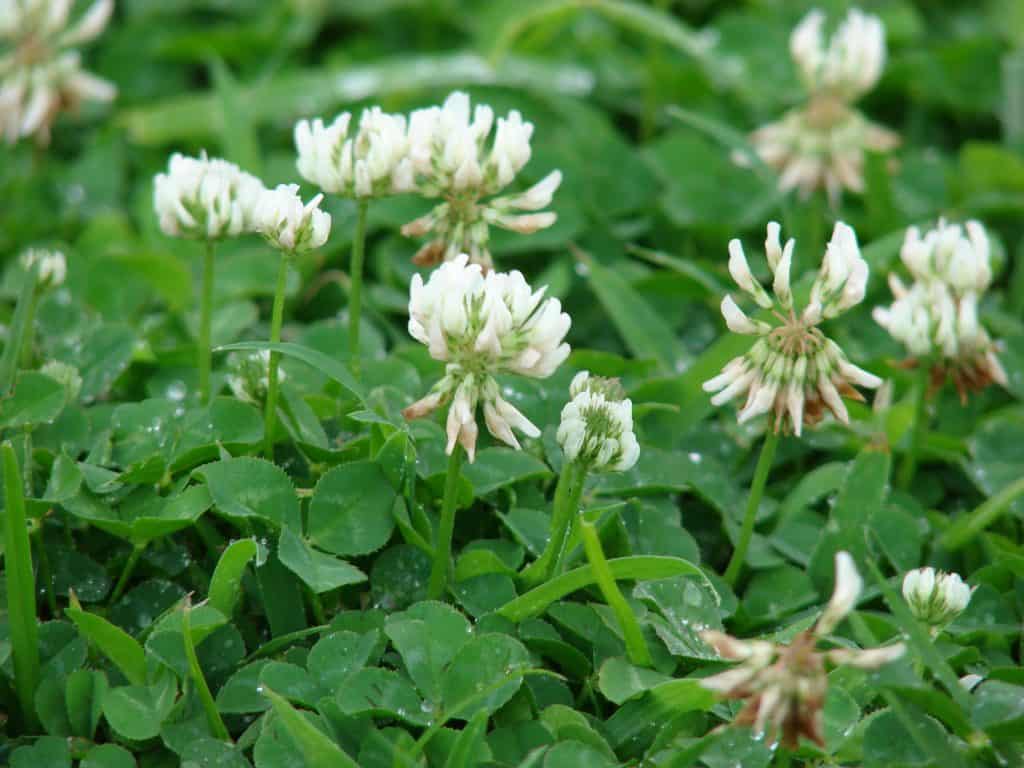
By Forest & Kim Starr, CC BY 3.0, https://commons.wikimedia.org/w/index.php?curid=6158742
Treatment(s)
- Manual removal in dense areas
- Multiple Fiesta Weed applications over more than one season
- Aeration & overseeding to crowd out, reduce density
- Frequent and consistent mowing at the proper height of 2.75-3" with a sharp blade. Bag clippings when the weeds are in flower and seed. Never allow the lawn to grow to more than 5". (Bag flowers when in bloom)
- Watering consistently each week by providing a minimum of 1" of water. do not water more than 2-3 times per week. Thunderstorms do not count.
Timeframe For Activity
- Low growing perennial weed
- Prefers clay based soil (typical of S. ON) but will grow in a variety of conditions
- Used in some instances to "fix" nitrogen (makes its own)
- Spreads through stolons/runners at or just under soil surface
Recommendations
- Mow every 5-7 days, maintaining height at 2 3/4" - 3"
- Collect clippings when in flower
- Fertilize well
Black Medic (Medicago lupulina)
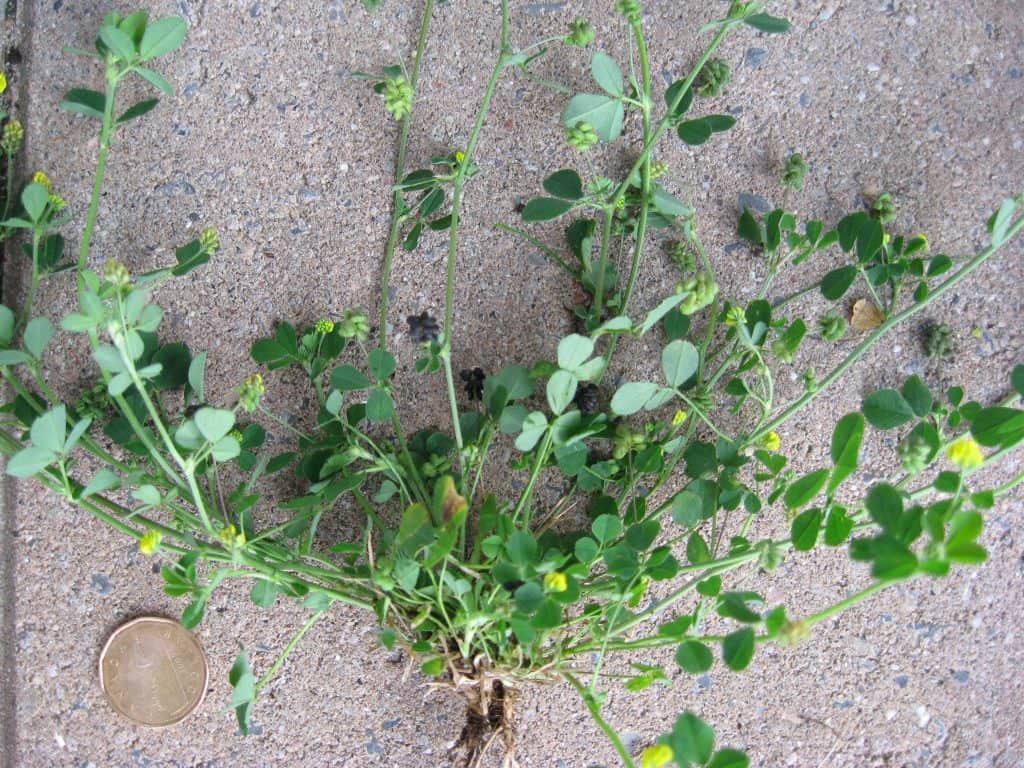
By The original uploader was Atubeileh at Arabic Wikipedia. - Transferred from ar.wikipedia to Commons by Limulus., CC BY-SA 2.5, https://commons.wikimedia.org/w/index.php?curid=7689810
- Manual removal in dense areas
- Aeration & overseeding to crowd out, reduce density
- Multiple Fiesta apps over more than one season
- Frequent and consistent mowing at the proper height of 2.75-3" with a sharp blade. Bag clippings when the weeds are in flower and seed. Never allow the lawn to grow to more than 5". *BAG CLIPPINGS WHEN IN FLOWER
- Watering consistently each week by providing a minimum of 1" of water. do not water more than 2-3 times per week. Thunderstorms do not count.
Info
- Low growing perennial, annual, or biennial weed, member of the clover family
- Small yellow flowers, leaves are longer & more narrow than clover
- Spreads through stolons/runners at or just under soil surface
- Tends to grow in circular clusters
Recommendations
- Mow every 5-7 days, maintaining height at 2 3/4" - 3"
- Collect clippings when in flower
- Fertilize well
Ground Ivy / “Creeping Charlie” (Glechoma hederacea)
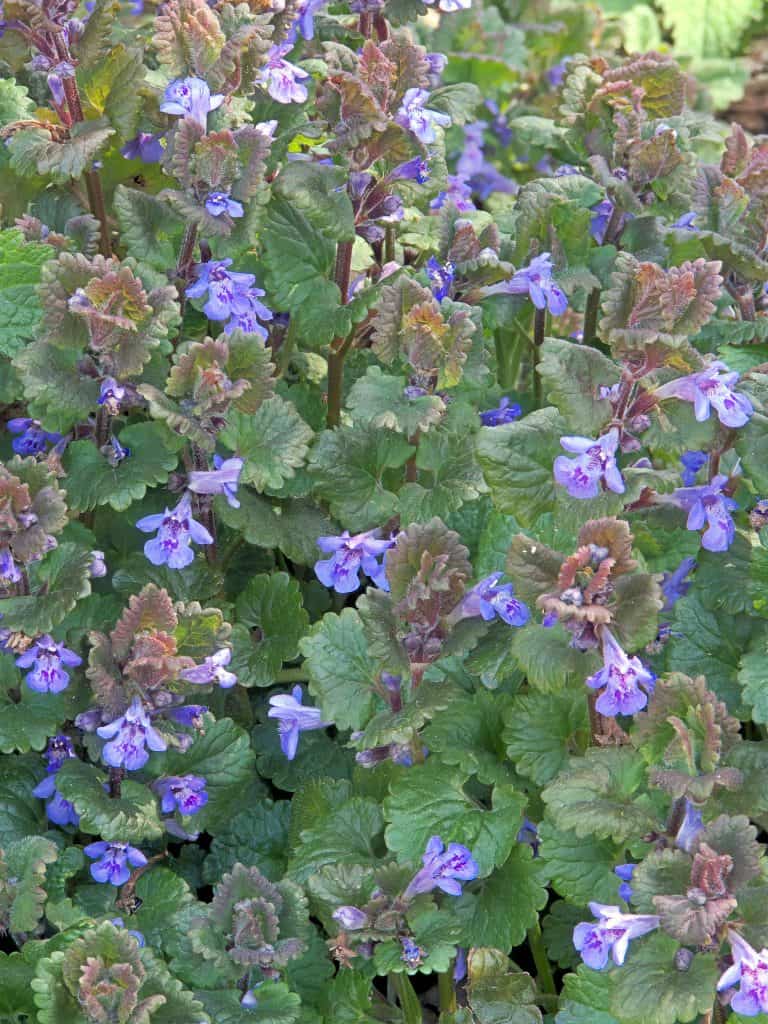
By Rasbak - Own work, CC BY-SA 3.0, https://commons.wikimedia.org/w/index.php?curid=10128264
Treatment(s)
- Manual removal in dense areas
- Proper mowing height (2 3/4" - 3", mowing every 5-7 days)
- Aeration & overseeding to crowd out, reduce density
- Multiple Fiesta apps over several years in combination with all above will help minimize, but NOT eliminate this weed.
Timeframe For Activity
- Thrives in moist, shady areas but will also grow in sun
- Lavender flowers in spring
Info
- Low growing perennial weed, member of the mint family
- Spreads through seeding and also stolons/runners at or just under soil surface
- Bright green leaves with scalloped edges, smells minty when crushed
Recommendations
- Mow every 5-7 days, maintaining height at 2 3/4" - 3"
- Collect clippings when in flower
- Fertilize well
Chickweed (common) (Stellaria media)
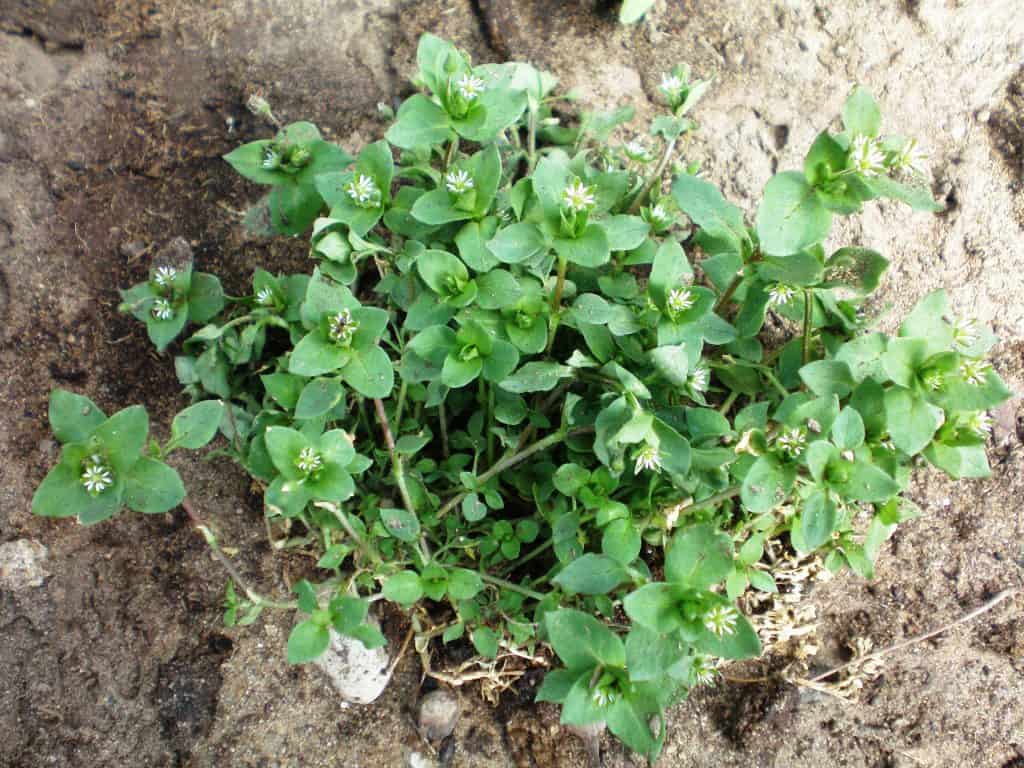
By I, Hugo.arg, CC BY-SA 3.0, https://commons.wikimedia.org/w/index.php?curid=2268301
Treatment(s)
- Manual removal in dense areas
- Aeration & overseeding to crowd out, reduce density
- Frequent and consistent mowing at the proper height of 2.75-3" with a sharp blade. Bag clippings when the weeds are in flower and seed. Never allow the lawn to grow to more than 5".
- Watering consistently each week by providing a minimum of 1" of water. do not water more than 2-3 times per week. Thunderstorms do not count.
Timeframe For Activity
- Prefers full sun to partially shaded areas
- Small white flowers
Info
- Low growing winter annual, branched creeping stems
- Spreads through stolons/runners at or just under soil surface
Recommendations
- Mow every 5-7 days, maintaining height at 2 3/4" - 3"
Purslane (Portulaca olerlcea)
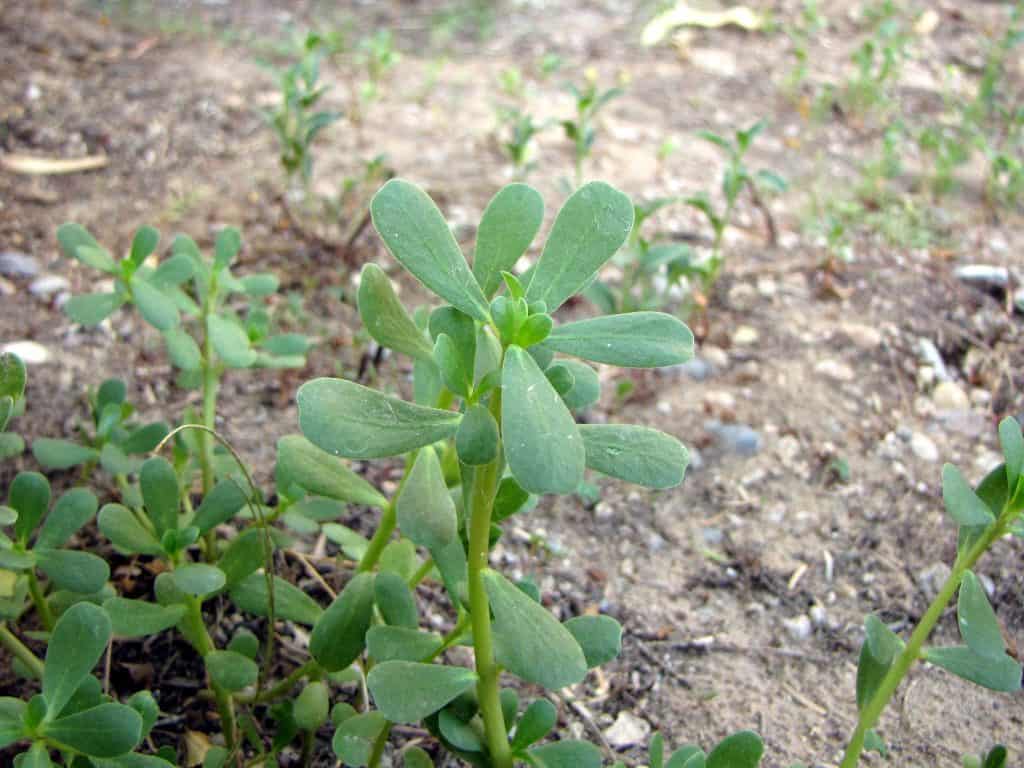
By ZooFari - Own work, CC BY-SA 3.0, https://commons.wikimedia.org/w/index.php?curid=8986945
Treatment(s)
- Manual removal proactively before seed heads are developed
- Proper mowing height (2 3/4" - 3", mowing every 5-7 days)
- Aeration & overseeding to crowd out, reduce density
Timeframe For Activity
- Germinates when soil temps reach between 21°C - 27°C
- Small yellow flowers with 5 parts
- Able to withstand drought conditions!
Info
- Low growing summer annual, reddish stems branching from a tap root
- succulent style leaves thrive in hot temperatures
- Aggressive root system allows for growth in compact soils
- Spreads through seeding
Recommendations
- Mow every 5-7 days, maintaining height at 2 3/4" - 3"
Spurge (Euphorbia maculata and E. supine)
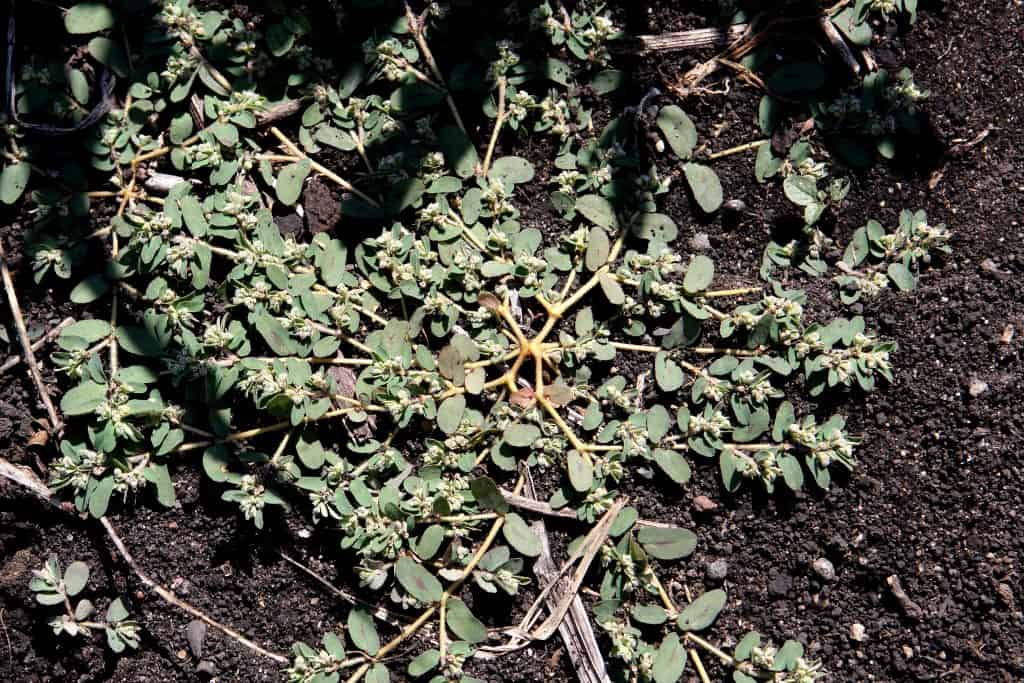
By Hardyplants at English Wikipedia - Own work, Public Domain, https://commons.wikimedia.org/w/index.php?curid=21034333
Treatment(s)
- Manual removal in dense areas before seedheads are produced
- Proper mowing height (2 3/4" - 3", mowing every 5-7 days)
- Aeration & overseeding to crowd out, reduce density
Timeframe For Activity
- Seeds when soil temps reach 12.5°C and continues all summer
- One plant can produce several thousand seeds per season
- Plants matures in hot weather
Info
- Low growing summer annual, reddish stems branching from a tap roots
- Small, oval opposite leaves vary from dark green to reddish brown
- Stems produce a milky white sap (noxious)
Recommendations
- Mow every 5-7 days, maintaining height at 2 3/4" - 3"
Wild Violet (Viola papilionacea)

By James Steakley - Own work, CC BY-SA 3.0, https://commons.wikimedia.org/w/index.php?curid=10003477
Treatment(s)
- Manual removal in dense areas
- Aeration & overseeding to crowd out, reduce density
- Frequent and consistent mowing at the proper height of 2.75-3" with a sharp blade. Bag clippings when the weeds are in flower and seed. Never allow the lawn to grow to more than 5".
- Watering consistently each week by providing a minimum of 1" of water. do not water more than 2-3 times per week. Thunderstorms do not count.
Timeframe For Activity
- Blooms March through May
- Small white or lilac to blue-lilac flowers
- Grows best in cool temps, prefers moist soil
Info
- 2" - 5" tall, heart shaped leaves
- Low growing perennial creeping weed
Recommendations
- Mow every 5-7 days, maintaining height at 2 3/4" - 3"
Henbit (Lamium amplexicaule)
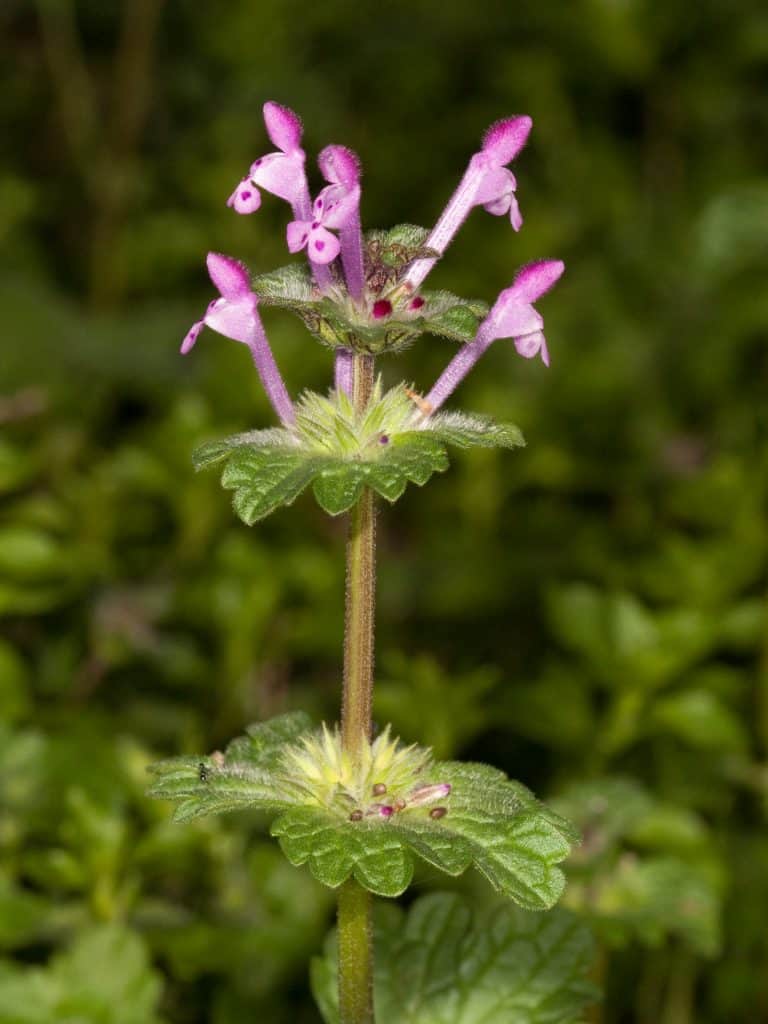
By Kaldari - Own work, CC0, https://commons.wikimedia.org/w/index.php?curid=8640496
Treatment(s)
- Manual removal in dense areas
- Aeration & overseeding to crowd out, reduce density
- Frequent and consistent mowing at the proper height of 2.75-3" with a sharp blade. Bag clippings when the weeds are in flower and seed. Never allow the lawn to grow to more than 5".
- Watering consistently each week by providing a minimum of 1" of water. do not water more than 2-3 times per week. Thunderstorms do not count.
Timeframe For Activity
- Germinates in the fall and flowers the following spring
Info
- Low growing winter annual with square stemmed branches
- Member of the mint family
- Coarsely toothed rounded leaves
Recommendations
- Mow every 5-7 days, maintaining height at 2 3/4" - 3"
Healall (Prunella vulgaris)
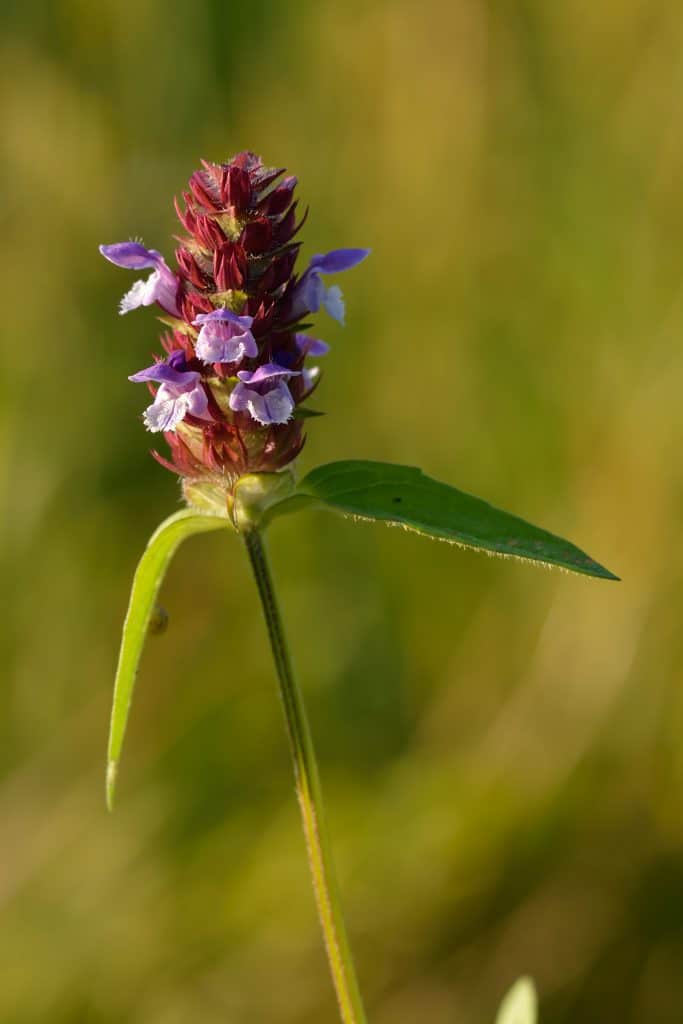
By Ivar Leidus - Own work, CC BY-SA 3.0, https://commons.wikimedia.org/w/index.php?curid=27062399
Treatment(s)
- Manual removal in dense areas
- Aeration & overseeding to crowd out, reduce density
- Frequent and consistent mowing at the proper height of 2.75-3" with a sharp blade. Bag clippings when the weeds are in flower and seed. Never allow the lawn to grow to more than 5".
- Watering consistently each week by providing a minimum of 1" of water. do not water more than 2-3 times per week. Thunderstorms do not count.
Timeframe For Activity
- Small pinecone-shaped purple flowers
Info
- Low growing perennial with ridged square stems
- Long oval leaves, smooth margins and appear 2 per node
- Spreads through seeding and also using short runners
Recommendations
- Mow every 5-7 days, maintaining height at 2 3/4" - 3"
Weed Grass Identification
Crabgrass
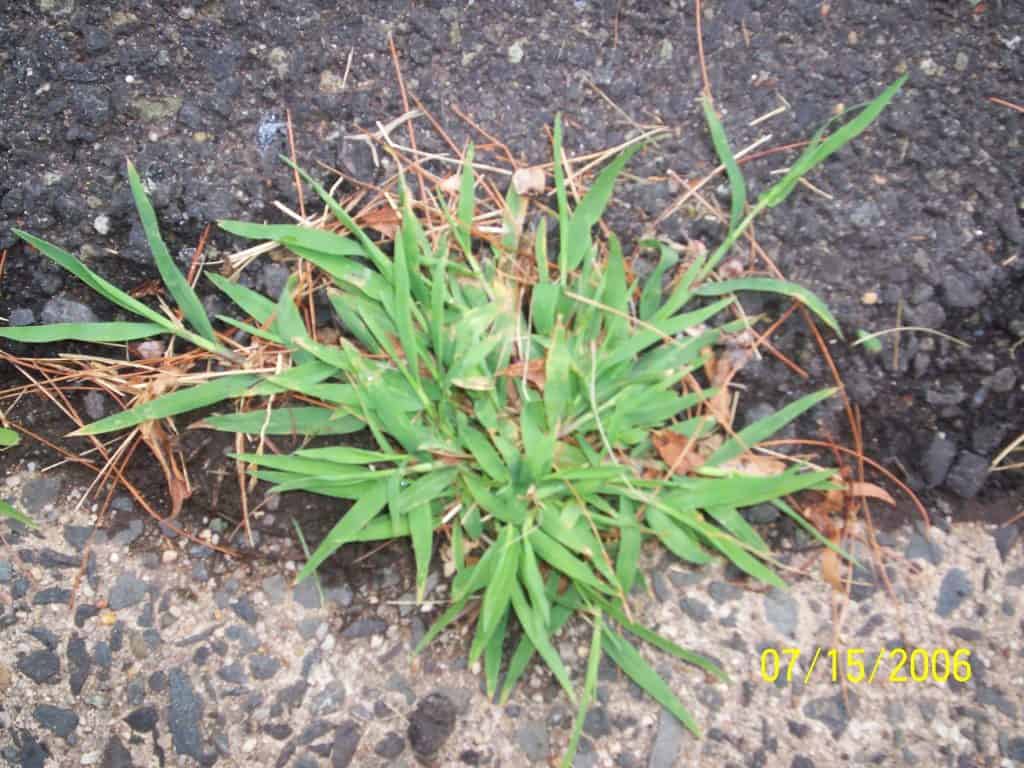
By The original uploader was Richard Arthur Norton (1958- ) at English Wikipedia. - Transferred from en.wikipedia to Commons by Off2riorob using CommonsHelper., CC BY 2.5, https://commons.wikimedia.org/w/index.php?curid=6902647
Info
- Spreads through seeding
- Seeds begin to germinate once soil temps reach 12.5°C - 15.5°C
- New growth is a brighter green colour
- Crabgrass plants produce seed mid summer - fall
- Crabgrass plants die over the winter months
Recommendations
- Can apply corn gluten to lawn as a method of inhibiting seed germination, however it may take several applications over a few seasons to see a visible reduction
- Pull out new growth as soon as it appears
- Easiest to manually remove when soil is moist
- Aerate and overseed annually to build turf density and crowd out crabgrass
What We Can Do
- Check along edges & driveways/sidewalks for any new growth - it can be pulled out by hand (watch our video!)
- Spot vegetation control
- Corn gluten meal over the next few seasons may help
- Aeration and overseeding services
Tall Fescue
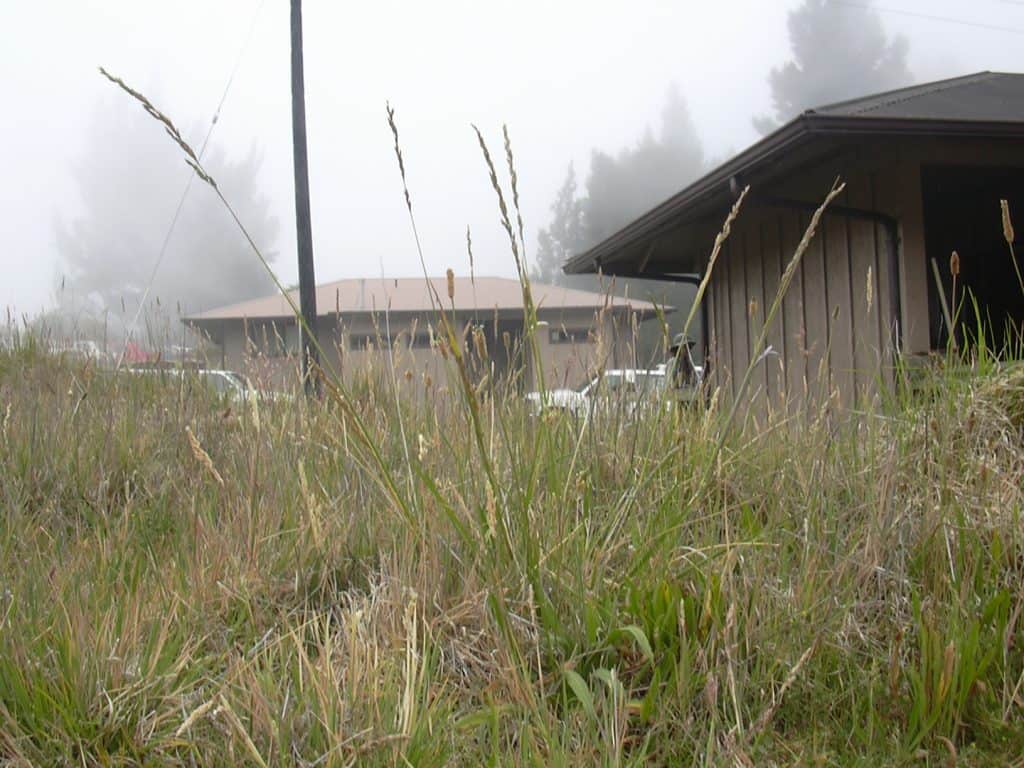
By Forest & Kim Starr, CC BY 3.0, https://commons.wikimedia.org/w/index.php?curid=6192078
Info
- Growth stops below 4°C
- Grows in bunches
- Prefers full sun but will grow in partial shade
- Root system can reach several feet in depth
- Deep roots allow tall fescue to tolerate drought
Recommendations
- Dig out clumps of tall fescue
- Difficult to manually remove due to depth of roots
- Aerate and overseed annually to build turf density and crowd out tall fescue
- Ensure lawn is mowed every 5-7 days, maintaining at 2 3/4" - 3" in height as this grass type thrives when allowed to grow taller
What We Can Do
- Aeration and overseeding services
- Spot vegetation control and seeding/topdressing
Quackgrass

By Rasbak - Own work, CC BY-SA 3.0, https://commons.wikimedia.org/w/index.php?curid=170853
Info
- Single blades of thicker, taller grass
- Spreads quickly using rhizomes
Recommendations
- Dig out areas of dense growth
- Difficult to manually remove due to depth of roots and structure of root system
- Aerate and overseed annually to build turf density and crowd out quackgrass
- Ensure lawn is mowed every 5-7 days, maintaining at 2 3/4" - 3" in height as this grass type thrives when allowed to grow tall
What We Can Do
- Aeration and overseeding services
- Spot vegetation control and re-seeding for areas of exceptionally dense growth
Bentgrass & Poa Annua (Annual bluegrass)
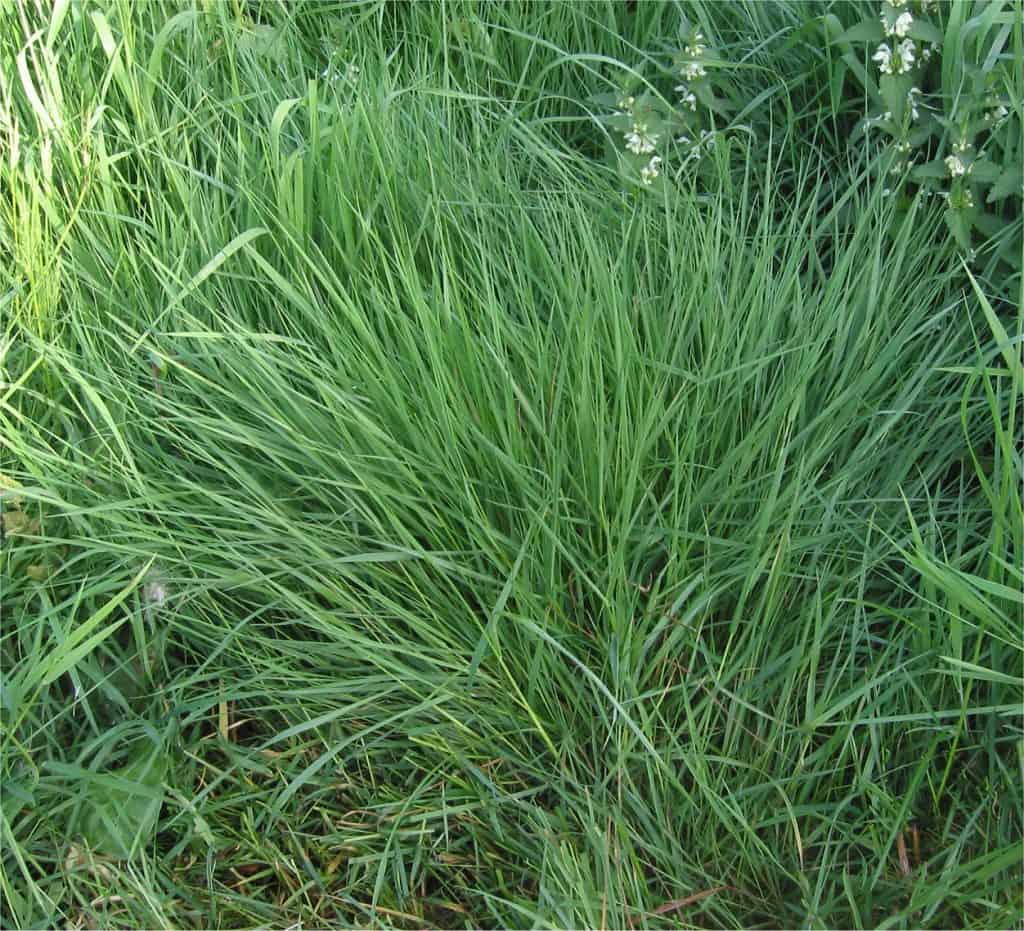
By Rasbak - Own work, CC BY-SA 3.0, https://commons.wikimedia.org/w/index.php?curid=168670
Info
- Desirable grass type for golf course greenss
- Very shallow root system
- Annual cool season grass
- Poa Annua has a Blueish-tint. Bent grass is more light green.
- Weaker grass type prone to discolouration & "browning out" in heat of summer
Recommendations
- Aerate and overseed annually to build turf density and introduce more resilient grass types
- Water deeply & less often to encourage deeper root growth
- Lightly rake out any damaged grass to allow for new growth of desirale seed types
What We Can Do
- Diagnose the problem first and explain the nature of this grass type
- Aeration and overseeding services
-
-
"*" indicates required fields






